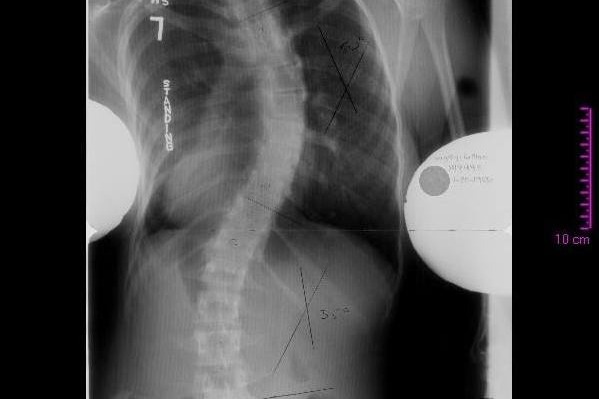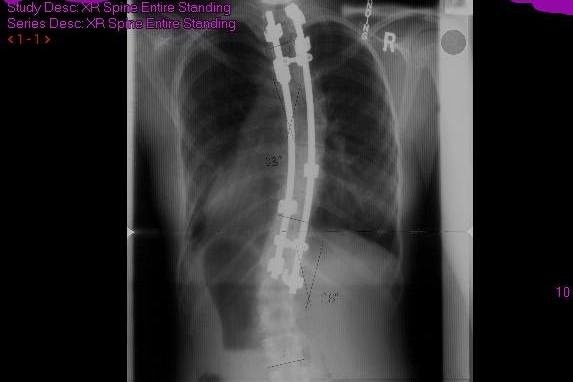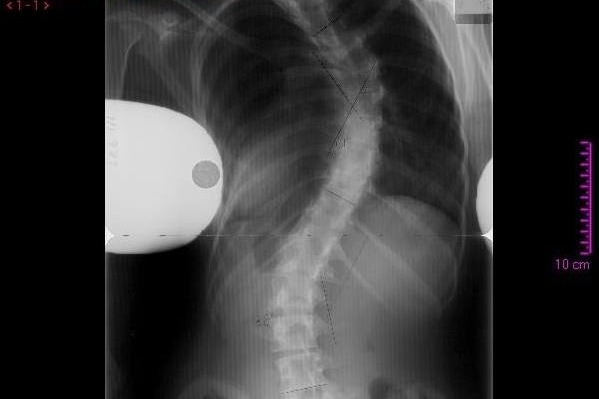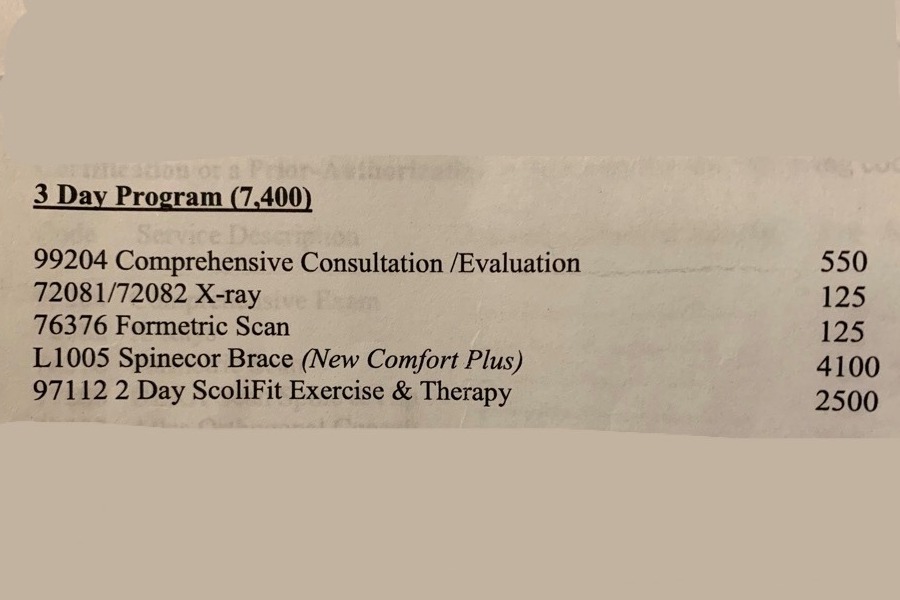
Have My Back: Help Gilly support her spine
Donation protected
As some of you may or may not know, I was diagnosed with severe, idiopathic scoliosis back in the 8th grade. You've all seen 16 Candles, right? The 1984, John Hughes classic starring Molly Ringwald? Remember the minor role Joan Cusack had, where she's sitting on the school bus, Milwaukee brace clear up to her chin, and she can barely turn her head? Or perhaps at the school dance when she's bent over trying to sip water from the drinking fountain, and it's dribbling all down her chin? Well that is the type of treatment that most adolescents with scoliosis curves under 45 degrees had to endure. Wearing that type of brace 24/7, and often only removing it for showering. My curvature, however, upon diagnosis was severe enough that the only really recommended treatment was an intense spinal fusion surgery, with a Herrington rod placement, taking bone from my hip to help secure both fusion points. That surgery would essentially straighten out my spine some, and prevent the curvature from progressing as I continued to grow. While both treatments sound less than ideal, going under anesthesia for an intense surgery for anything is always a risk.
Initially, and understandably so, my mother wanted to seek out other, non-surgical options for me and my spine. So for a few months we commuted up to Eagan MN 3 times a week, to a chiropractor whom specialized in a particular adjusting method for people with scoliosis. The goal was to do this chiropractic adjusting to help decrease the curvature of my spine, and prevent it from progressing. While this particular adjustment technique had been proven to work, this chiropractor had only ever used it/had success with it on patients with curvatures of around 12 degrees or less. He was willing to give it a go for me, but couldn't guarantee any type of success.
Unfortunately for me, and to nobody's fault, the chiropractic treatment did not work. After a few months of trying, my spine started to lose a lot of it's mobility, thus needing to move forward with surgery.
Pre-spinal fusion/rod placement:

Surgery happened on July 11th, 2000. Right in the throws of summer, which meant I didn't miss any school, but missed out on a lot of summer fun. I don't remember whether or not the recovery time felt extreme. What I do remember is eventually feeling great, but still not being allowed to do much physical activity at all. Which for someone going into 9th grade, and who hails from a relatively active family, that is rather torturous. However, my spine was significantly straighter. HOLY COW was it straighter! And I remember feeling rather cool, as if I was some secretly bionic girl, who had to carry around a card to prove her bionic status, anytime she set off metal detectors.
Post spinal fusion/rod placement:

Initially the spinal fusion/rod placement seemed to go extremely well. That is until about 7ish months later when I started having a lot of back pain. A few CT scans, 1 scan that was not the scan that my doctor ordered, and a 3hr MRI later, my doctor determined that I was in the 1 percentile of individuals in which spinal fusion did not take/failed. Thus back I went in for surgery on May 11th of 2001, so that he could remove more bone from my hip to secure those spinal fusion points again. Upon waking up from this second surgery I remember thinking--in my post-surgery groggy state--that two things were weird. #1 being that I was not in ICU, unlike I was for my first surgery. #2 wondering why my hip did not hurt, unlike when they removed bone from my hip the first time. Turns out, my mother informed me as soon as she saw I was awake-ish, that my fusion had not actually failed. However what had happened, was that my body had started to reject the metal, the Harrington rods, causing a massive infection in my back that had not shown up in my blood work. So instead of removing more bone to secure the fusion points, my doctor had to remove the rods (I never even had the chance to flash my bionic girl badge to anyone yet), and I had to be on IV antibiotics for 3 weeks post hospital stay. Additionally I had to wear a rigid, post-op back brace for over a year (originally supposed to be only 6 months). No, this was not like the Milwaukee brace that Joan Cusack had to wear in 16 Candles, it did not go all the way up to my chin. But it did require a whole new wardrobe of baggy shirts, and elastic waistbands to fit over the brace, which is ever so stylist for someone going into the 10th grade.
Even with the back brace, after the rods had been removed, my spine reverted back to the curvature degrees it had been just prior to my first surgery. The plan at that point, was to simply monitor my curvature to see that it didn't continue to progress. The ultimate hope was that my spine would stay where it was at, because placing rods back on my spine to prevent further curvature progression, was likely to put me at risk for another infection. While thankfully my back did, and has managed to stay relatively the same curvature degrees over since that surgery in 2001. However that meant that I likely had (have had) to live with a significantly curved spine, a shoulder blade hunch on my right side, and a decreased lung capacity (my spine also twists/rotates a bit, pushing on my lungs).
Post-rod removal:

Fast forward to a few years ago, I read about a specific therapy treatment for individuals with scoliosis called the Schroth Method. The method itself was invented by a woman named Katharina Schroth, out of Germany, who suffered from moderate scoliosis herself. While the Schroth method has been around for many decades now, it didn't start to gain a whole lot of traction in the mainstream medicine world (that I know of) until likely the last decade. Upon reading about this Schroth method, it was said that it had been proven to decrease spinal curvatures, increase mobility/flexibility, decrease pain, and increase lung capacity. Specifically in those newly diagnosed adolescents, but also in adults with scoliosis (though decreasing spine curvature is not always to be as significant in adult scoliosis). Naturally someone with my spine I wanted in on the action, but was saddened to learn that while there was nobody in MN that was Schroth certified, all of the therapy programs out of state that I found were long, and consisted of therapy nearly every day for the first week or two, with follow up sessions gradually decreasing in time and frequency over 10-16 months. Thus making traveling to another state out of the question. Slowly overtime I stopped thinking about it, going to the chiropractor when I was desperate, getting a massage or floating in a sensory deprivation tank when the wallet could afford it. Using my tens unit regularly, to help fight off the chronic back pain that occurs when I sleep.
Late last year I decided it was finally time that I started to do something about my spine/posture. Working as a dog groomer is a rather physically demanding career, and I want to make sure that I retire from the profession by choice, and not because my body forces me to. I also enjoy hiking, kayaking/canoeing, and have been working out somewhat regularly to help me stay in shape. I want to be able to continue to do those things, and more, well into old age. So I started going to a spine and wellness clinic across from my work, to see if they might be able to help me with my posture at all. Getting adjusted each week, and working with their mobility specialists. Though not as often as they would like me to be going, thanks to our ever so wonderful healthcare system. I have been continually going to this clinic since last fall now, however with any kind of physical therapy, exercising, and even chiropractic work, I am always wondering whether what I'm doing is good for my spine, or causing more damage. So when a Scoliosis specialty clinic out in NYC that specializes in Schroth method therapy/bracing started following me on Instagram 4 weeks ago, I got really excited with everything that they do, and all their success stories. But I expressed a sadness on how far away they were located in relation to me, as the last time I had checked there was nobody Schroth certified in MN. In turn they reached out to me, informing me that they offer 3 day therapy training programs, not just in NYC, but in several cities all over the USA. While they initially suggested I swing down to Chicago, I realized that with a 3 day training program, I could go to NYC for the program, and stay with my east coast family (brother, sis in-law, and niece).
Here is the catch,--and another checkmark on the "why the United States healthcare system sucks" ballot--pretty much all Schroth certified clinics are considered out-of-network, thus health insurance coverage is going to be incredibly minimal, if any at all. Not to mention the thought of any insurance assistance with out-of-network medical equipment is laughable. While I'm still planning to get preauthorization letters from my primary care doctor for all of this, just in case. I figure it is better to bank on 0 insurance assistance, and be surprised later. Then to bank on even a little assistance, and be short money come time to pay.
So, here is the breakdown of what this 3 day program will cost me out of pocket, with 0 help from insurance:

Right now I have about 2/3 of the 3 day program saved. I was originally saving up to finally get my arse out of the country this year, but have now decided that I need this therapy even more. The individual at the clinic that I have been conversing with via email had mentioned that they would likely comp me the initial evaluation fee if I committed to their 3 day program, which would put me at having nearly the majority of the therapy program saved. However I am not going to bank on that generous offer just yet. My main concern that I have right now, is with the cost of this Spinecor Brace. It is $4,000, and considered to be that "medical equipment" that insurance won't cover from out-of-network clinics. While this brace will be absolutely necessary for this treatment, and the betterment of my spine. It is also something I now desperately desire, after reading everything people have to say about it, how much it helps to correct posture, and relieve back pain. Just sitting here now at my desk all evening, writing up this Gofundme story, I have significant discomfort in my back/spine. And while I consider my tens unit a life saver, as I wouldn't be able to sleep without using it regularly. It does not help with all my pain and discomfort.
Just tell me, does this brace not just look like an all day hug to you?

I am the type of person that has a hard time asking for help with things, money related or otherwise, so I was hesitant to make this Gofundme. But I am confident that this program will be the best thing I can do for myself, and that this clinic specifically is the place for me to do it. I don't want anyone to feel obligated to contribute, but if you are able to throw some bones (pun intended!) my way, I would be eternally grateful. If you can't afford to contribute, I completely understand, and simply ask that you consider sharing this campaign, so that I might have the opportunity to get as much funding as I can.
Thank you so much!
-Gilly
Initially, and understandably so, my mother wanted to seek out other, non-surgical options for me and my spine. So for a few months we commuted up to Eagan MN 3 times a week, to a chiropractor whom specialized in a particular adjusting method for people with scoliosis. The goal was to do this chiropractic adjusting to help decrease the curvature of my spine, and prevent it from progressing. While this particular adjustment technique had been proven to work, this chiropractor had only ever used it/had success with it on patients with curvatures of around 12 degrees or less. He was willing to give it a go for me, but couldn't guarantee any type of success.
Unfortunately for me, and to nobody's fault, the chiropractic treatment did not work. After a few months of trying, my spine started to lose a lot of it's mobility, thus needing to move forward with surgery.
Pre-spinal fusion/rod placement:

Surgery happened on July 11th, 2000. Right in the throws of summer, which meant I didn't miss any school, but missed out on a lot of summer fun. I don't remember whether or not the recovery time felt extreme. What I do remember is eventually feeling great, but still not being allowed to do much physical activity at all. Which for someone going into 9th grade, and who hails from a relatively active family, that is rather torturous. However, my spine was significantly straighter. HOLY COW was it straighter! And I remember feeling rather cool, as if I was some secretly bionic girl, who had to carry around a card to prove her bionic status, anytime she set off metal detectors.
Post spinal fusion/rod placement:

Initially the spinal fusion/rod placement seemed to go extremely well. That is until about 7ish months later when I started having a lot of back pain. A few CT scans, 1 scan that was not the scan that my doctor ordered, and a 3hr MRI later, my doctor determined that I was in the 1 percentile of individuals in which spinal fusion did not take/failed. Thus back I went in for surgery on May 11th of 2001, so that he could remove more bone from my hip to secure those spinal fusion points again. Upon waking up from this second surgery I remember thinking--in my post-surgery groggy state--that two things were weird. #1 being that I was not in ICU, unlike I was for my first surgery. #2 wondering why my hip did not hurt, unlike when they removed bone from my hip the first time. Turns out, my mother informed me as soon as she saw I was awake-ish, that my fusion had not actually failed. However what had happened, was that my body had started to reject the metal, the Harrington rods, causing a massive infection in my back that had not shown up in my blood work. So instead of removing more bone to secure the fusion points, my doctor had to remove the rods (I never even had the chance to flash my bionic girl badge to anyone yet), and I had to be on IV antibiotics for 3 weeks post hospital stay. Additionally I had to wear a rigid, post-op back brace for over a year (originally supposed to be only 6 months). No, this was not like the Milwaukee brace that Joan Cusack had to wear in 16 Candles, it did not go all the way up to my chin. But it did require a whole new wardrobe of baggy shirts, and elastic waistbands to fit over the brace, which is ever so stylist for someone going into the 10th grade.
Even with the back brace, after the rods had been removed, my spine reverted back to the curvature degrees it had been just prior to my first surgery. The plan at that point, was to simply monitor my curvature to see that it didn't continue to progress. The ultimate hope was that my spine would stay where it was at, because placing rods back on my spine to prevent further curvature progression, was likely to put me at risk for another infection. While thankfully my back did, and has managed to stay relatively the same curvature degrees over since that surgery in 2001. However that meant that I likely had (have had) to live with a significantly curved spine, a shoulder blade hunch on my right side, and a decreased lung capacity (my spine also twists/rotates a bit, pushing on my lungs).
Post-rod removal:

Fast forward to a few years ago, I read about a specific therapy treatment for individuals with scoliosis called the Schroth Method. The method itself was invented by a woman named Katharina Schroth, out of Germany, who suffered from moderate scoliosis herself. While the Schroth method has been around for many decades now, it didn't start to gain a whole lot of traction in the mainstream medicine world (that I know of) until likely the last decade. Upon reading about this Schroth method, it was said that it had been proven to decrease spinal curvatures, increase mobility/flexibility, decrease pain, and increase lung capacity. Specifically in those newly diagnosed adolescents, but also in adults with scoliosis (though decreasing spine curvature is not always to be as significant in adult scoliosis). Naturally someone with my spine I wanted in on the action, but was saddened to learn that while there was nobody in MN that was Schroth certified, all of the therapy programs out of state that I found were long, and consisted of therapy nearly every day for the first week or two, with follow up sessions gradually decreasing in time and frequency over 10-16 months. Thus making traveling to another state out of the question. Slowly overtime I stopped thinking about it, going to the chiropractor when I was desperate, getting a massage or floating in a sensory deprivation tank when the wallet could afford it. Using my tens unit regularly, to help fight off the chronic back pain that occurs when I sleep.
Late last year I decided it was finally time that I started to do something about my spine/posture. Working as a dog groomer is a rather physically demanding career, and I want to make sure that I retire from the profession by choice, and not because my body forces me to. I also enjoy hiking, kayaking/canoeing, and have been working out somewhat regularly to help me stay in shape. I want to be able to continue to do those things, and more, well into old age. So I started going to a spine and wellness clinic across from my work, to see if they might be able to help me with my posture at all. Getting adjusted each week, and working with their mobility specialists. Though not as often as they would like me to be going, thanks to our ever so wonderful healthcare system. I have been continually going to this clinic since last fall now, however with any kind of physical therapy, exercising, and even chiropractic work, I am always wondering whether what I'm doing is good for my spine, or causing more damage. So when a Scoliosis specialty clinic out in NYC that specializes in Schroth method therapy/bracing started following me on Instagram 4 weeks ago, I got really excited with everything that they do, and all their success stories. But I expressed a sadness on how far away they were located in relation to me, as the last time I had checked there was nobody Schroth certified in MN. In turn they reached out to me, informing me that they offer 3 day therapy training programs, not just in NYC, but in several cities all over the USA. While they initially suggested I swing down to Chicago, I realized that with a 3 day training program, I could go to NYC for the program, and stay with my east coast family (brother, sis in-law, and niece).
Here is the catch,--and another checkmark on the "why the United States healthcare system sucks" ballot--pretty much all Schroth certified clinics are considered out-of-network, thus health insurance coverage is going to be incredibly minimal, if any at all. Not to mention the thought of any insurance assistance with out-of-network medical equipment is laughable. While I'm still planning to get preauthorization letters from my primary care doctor for all of this, just in case. I figure it is better to bank on 0 insurance assistance, and be surprised later. Then to bank on even a little assistance, and be short money come time to pay.
So, here is the breakdown of what this 3 day program will cost me out of pocket, with 0 help from insurance:

Right now I have about 2/3 of the 3 day program saved. I was originally saving up to finally get my arse out of the country this year, but have now decided that I need this therapy even more. The individual at the clinic that I have been conversing with via email had mentioned that they would likely comp me the initial evaluation fee if I committed to their 3 day program, which would put me at having nearly the majority of the therapy program saved. However I am not going to bank on that generous offer just yet. My main concern that I have right now, is with the cost of this Spinecor Brace. It is $4,000, and considered to be that "medical equipment" that insurance won't cover from out-of-network clinics. While this brace will be absolutely necessary for this treatment, and the betterment of my spine. It is also something I now desperately desire, after reading everything people have to say about it, how much it helps to correct posture, and relieve back pain. Just sitting here now at my desk all evening, writing up this Gofundme story, I have significant discomfort in my back/spine. And while I consider my tens unit a life saver, as I wouldn't be able to sleep without using it regularly. It does not help with all my pain and discomfort.
Just tell me, does this brace not just look like an all day hug to you?

I am the type of person that has a hard time asking for help with things, money related or otherwise, so I was hesitant to make this Gofundme. But I am confident that this program will be the best thing I can do for myself, and that this clinic specifically is the place for me to do it. I don't want anyone to feel obligated to contribute, but if you are able to throw some bones (pun intended!) my way, I would be eternally grateful. If you can't afford to contribute, I completely understand, and simply ask that you consider sharing this campaign, so that I might have the opportunity to get as much funding as I can.
Thank you so much!
-Gilly
Organizer
Gilly Wigley
Organizer
St. Paul, MN